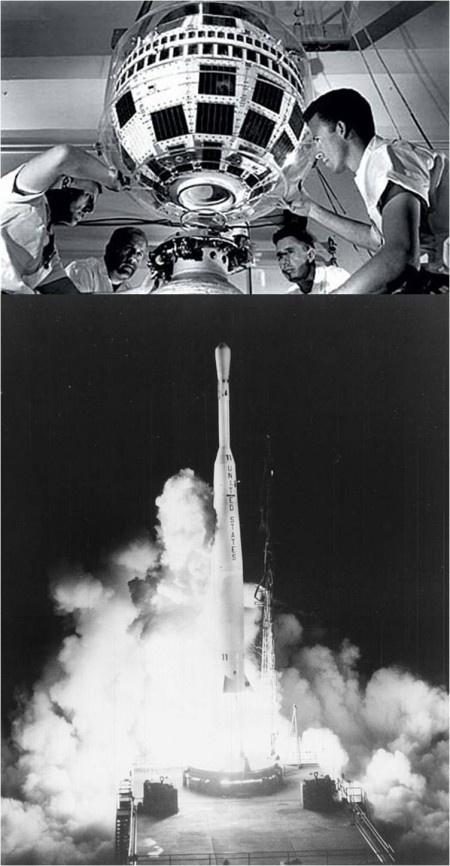Fifty-one years ago this week, the United States successfully orbited the world’s first active-repeater communications satellite. Known as Telstar 1, the satellite successfully relayed through space the first television pictures, telephone calls, fax images and provided the first live transatlantic television transmission.
Telstar was a development of the Bell Telephone Laboratories for the American Telephone and Telegraph (AT&T) Company. The concept involved orbiting of a satellite that could receive, amplify and retransmit electromagnetic signals around the globe.
The Telstar satellite was spherical in shape, had a diameter of 34.5 inches, and weighed about 170 lbs. Its external surface was covered with solar cells for electrical power generation. Telstar 1 was equipped with a single transponder and an externally located antenna array.
On Tuesday, 10 July 1962, Telstar 1 was launched into space aboard a Thor Delta launch vehicle. Lift-off from Cape Canaveral’s LC-17B came at 08:35 UTC. The satellite was successfully placed into a highly elliptical 3,046 nm x 510 nm orbit with an inclination of 45 degrees and a period of 157.8 minutes.
Telstar 1’s non-geosynchronous orbit limited its availability for transatlantic signals to about 20 minutes during each orbital pass. The power of the satellite’s transponder was quite low. To compensate, ground station antennas had to be very large. These units measured 177 feet in length and weighed around 750,000 lbs.
Once in orbit, Telstar 1 went right to work. On Wednesday, 11 July 1962, the satellite successfully relayed its first television signals in a transmission that originated in the United States. Specifically, images of the American flag were relayed to a ground station in France. While image quality was crude by today’s standards, Old Glory still looked pretty good in this first broadcast.
Telstar 1 made its inaugural public transatlantic broadcast on Monday, 23 July 1962. This historic broadcast featured the Statue of Liberty, the Eiffel Tower, remarks by President John F. Kennedy, excerpts from a baseball game between the Philadelphia Phillies and the Chicago Cubs, images of the American flag waving in the breeze, and pictures of Yves Montand, a then-popular French singer.
Telstar 1 transmitted more than 400 telephone, telegraph, fax and television transmissions during a rather abbreviated operational career. In November 1962, Telstar 1’s onboard electronics malfunctioned due to the harsh radiation environment encountered during repeated passage through the Van Allen Radiation Belts. Residual space-borne radiation from recent U.S. and Soviet nuclear weapons testing in space also contributed to the satellite’s demise.
Telstar 1 ushered in a new era in global communications. Its revolutionary technology profoundly changed life on earth in that global connectivity became more immediate and intimate. Telstar also spawned a new industry that has evolved into today’s massive global telecommunications market. Not too bad for a little ball filled with transistors, broadcasting with a weak transponder and orbiting high in the radiation-drenched heavens.

